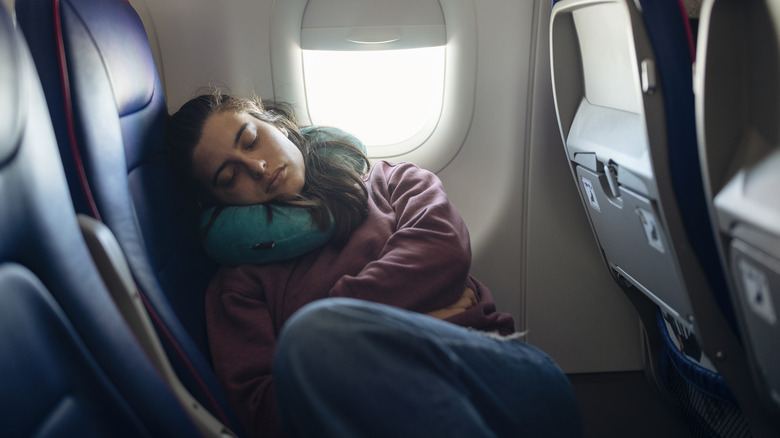Sometimes, the most popular content on TikTok is also the most divisive. Case in point: a nine-second video demonstrating a simple hack for sleeping better on a plane. The clip was posted by user @alexisburnaby1711 and has since earned a whopping 2 million “likes” on the platform.
Rather than being another travel pillow hack or a new spin on the military sleep hack, the content creator’s strategy is all about seatbelt placement. “To whoever it was that said to put the plane belt around your ankles … I owe you my life!!!!” reads text on the viral video. The footage shows the TikToker lounging on a flight with her knees up and her seatbelt tightly fastened around her legs.
However, commenters pointed out potential issues with the hack, noting that it looked unsafe and like a “medical emergency waiting to happen.” But is it really so dangerous to put your seatbelt around your ankles? To find out, Explore exclusively reached out to Barbi, a journalist and flight attendant with 38 years of experience at a major U.S. airline. She shared her insights on how to stay comfortable at 30,000 feet without risking personal safety.
The TikTok sleeping hack could cause injuries and blood clots

If your preferred sleep position on a plane involves putting your feet up and reclining your seat, the TikTok seatbelt hack might look pretty cozy. Unfortunately, it could also put your life at risk during an emergency. “When worn correctly, low and tight around your hips, the seatbelt is meant to keep you from flying out of your seat and becoming a projectile in the cabin and hurting yourself or others during turbulence,” Barbi explained. “Second, according to the National Transportation Safety Board (NTSB), if passengers are wearing their seatbelts properly, the odds of them suffering injuries in such situations are very low.”
Barbi added that getting tossed around due to turbulence and wind shear can happen at any time, sometimes without warning. If you’re not prepared, or if you have to fumble with your seatbelt to get it in the correct position, you could be thrown from your seat. “Putting the seatbelt around your ankles and keeping your knees up will not prevent you from flying out of your seat in these situations — it’s a matter of physics,” said the flight attendant.
Another issue to worry about: blood clots. Clots can develop during long flights due to prolonged immobility, including sitting in the same position on a plane for hours. Barbi warned, “The TikTok seatbelt hack doesn’t allow for great circulation and can put someone in danger of developing a life-threatening blood clot.”
How to get comfortable on a long flight

Skipping the TikTok hack doesn’t mean you’re bound to lose sleep on your flight. There are plenty of other genius tips that make sleeping on a flight comfier, including Barbi’s go-to sleep hack. She told Explore, “After takeoff, I slide my bag from under the seat in front of me so I can slide my feet and legs in its place. This creates extra legroom while still allowing me to wear my seatbelt properly.” If you prefer to keep your feet elevated, the frequent flier suggested using a small bag as a footrest.
Barbi noted that regardless of how you choose to snooze, you should keep your seatbelt fastened at all times, not only when the seatbelt sign is illuminated. As she explained, the sign is switched off only to let passengers know it’s safe to move around the cabin. If you plan to stay seated, especially while sleeping, it’s best to keep your seatbelt positioned around your hips.
When the seatbelt sign does turn back on, you’ll already be prepared, even if you’re dozing — which could save you from getting a hefty fine. “It’s a federal offense to ignore illuminated safety signs, and not wearing your seatbelt properly can result in a fine of up to $10,000,” said Barbi. “We’re not trying to make your life uncomfortable when we tell you [that] you need to wear your seatbelt correctly. We’re just trying to keep you safe — it’s our job.”

